engine coolant OPEL KARL 2018.5 Manual user
[x] Cancel search | Manufacturer: OPEL, Model Year: 2018.5, Model line: KARL, Model: OPEL KARL 2018.5Pages: 203, PDF Size: 5.64 MB
Page 62 of 203

60Instruments and controlsInstruments and
controlsControls ....................................... 61
Steering wheel adjustment ........61
Steering wheel controls .............61
Heated steering wheel ...............61
Horn ........................................... 62
Windscreen wiper and washer ..62
Rear window wiper and washer ...................................... 63
Outside temperature ..................63
Clock ......................................... 63
Power outlets ............................. 65
Cigarette lighter ......................... 65
Ashtrays .................................... 65
Warning lights, gauges and indi‐ cators ........................................... 65
Instrument cluster ......................65
Speedometer ............................. 65
Odometer .................................. 66
Trip odometer ............................ 66
Tachometer ............................... 66
Fuel gauge ................................ 66
Fuel selector .............................. 67
Engine coolant temperature gauge ....................................... 68Service display.......................... 69
Control indicators ......................70
Turn lights .................................. 72
Seat belt reminder .....................73
Airbag and belt tensioners .........73
Airbag deactivation ....................73
Charging system .......................74
Malfunction indicator light ..........74
Service vehicle soon .................74
Brake and clutch system ...........74
Operate pedal ............................ 74
Antilock brake system (ABS) .....75
Gear shifting .............................. 75
Power steering .......................... 75
Lane departure warning ............75
Ultrasonic parking assist ...........75
Electronic Stability Control off ...75
Electronic Stability Control and Traction Control system ...........75
Traction Control system off .......76
Engine coolant temperature ......76
Tyre pressure monitoring system ...................................... 76
Engine oil pressure ....................76
Low fuel ..................................... 77
Immobiliser ................................ 77
Reduced engine power .............77
Exterior light .............................. 77
High beam ................................. 77
Fog light ..................................... 77Rear fog light............................. 77
Cruise control ............................ 77
Speed limiter ............................. 77
Bonnet open .............................. 77
Door open .................................. 78
Displays ....................................... 78
Driver Information Centre ..........78
Info Display ................................ 83
Vehicle messages ........................84
Warning chimes .........................86
Battery voltage .......................... 86
Vehicle personalisation ................87
Telematics service .......................89
OnStar ....................................... 89
Page 69 of 203
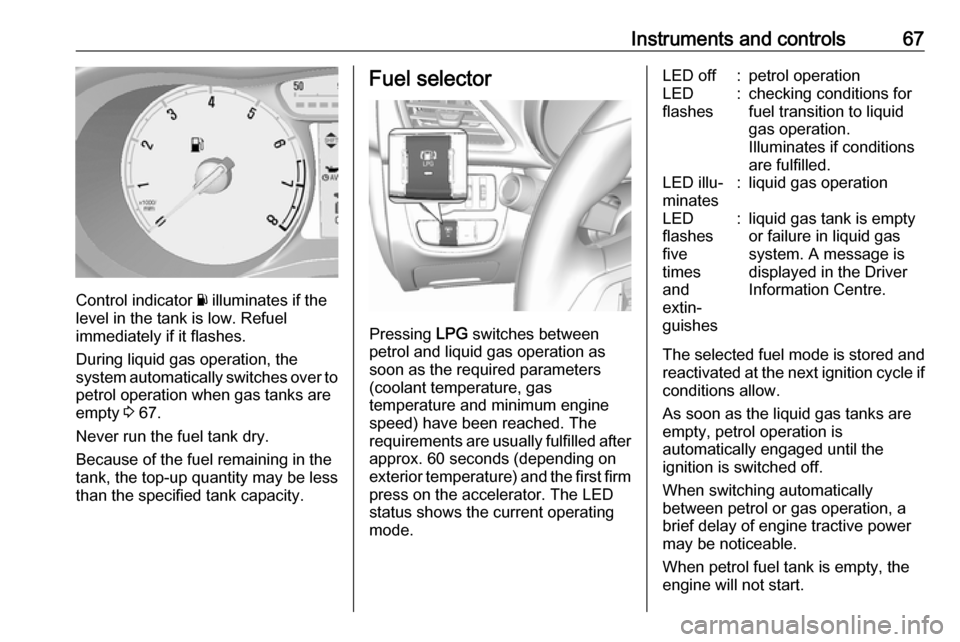
Instruments and controls67
Control indicator Y illuminates if the
level in the tank is low. Refuel
immediately if it flashes.
During liquid gas operation, the
system automatically switches over to
petrol operation when gas tanks are
empty 3 67.
Never run the fuel tank dry.
Because of the fuel remaining in the
tank, the top-up quantity may be less
than the specified tank capacity.
Fuel selector
Pressing LPG switches between
petrol and liquid gas operation as
soon as the required parameters (coolant temperature, gas
temperature and minimum engine
speed) have been reached. The
requirements are usually fulfilled after
approx. 60 seconds (depending on
exterior temperature) and the first firm press on the accelerator. The LED
status shows the current operating
mode.
LED off:petrol operationLED
flashes:checking conditions for
fuel transition to liquid
gas operation.
Illuminates if conditions
are fulfilled.LED illu‐
minates:liquid gas operationLED
flashes
five
times
and
extin‐
guishes:liquid gas tank is empty
or failure in liquid gas
system. A message is
displayed in the Driver
Information Centre.
The selected fuel mode is stored and reactivated at the next ignition cycle if
conditions allow.
As soon as the liquid gas tanks are
empty, petrol operation is
automatically engaged until the
ignition is switched off.
When switching automatically
between petrol or gas operation, a
brief delay of engine tractive power
may be noticeable.
When petrol fuel tank is empty, the
engine will not start.
Page 70 of 203
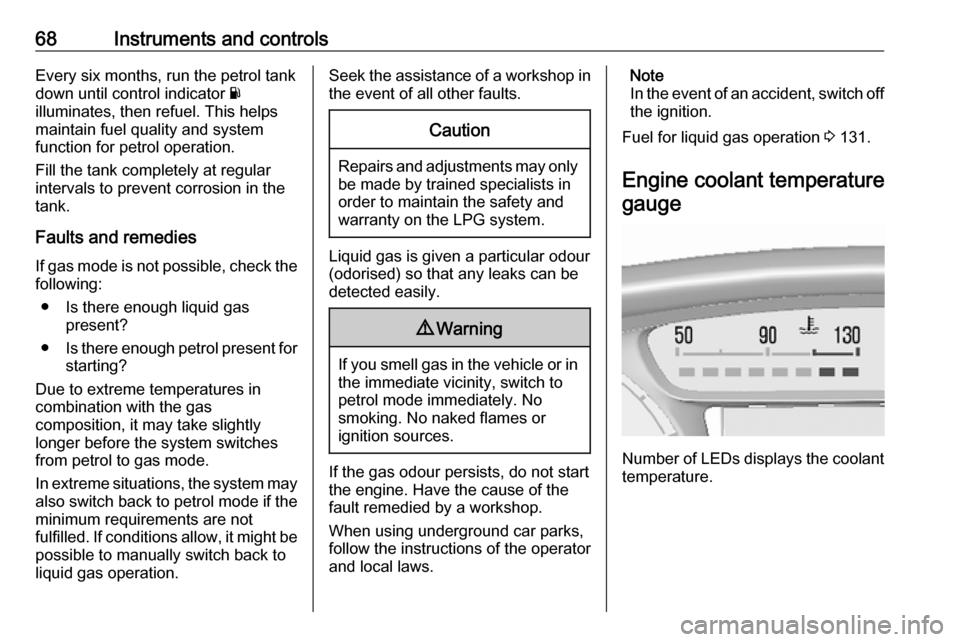
68Instruments and controlsEvery six months, run the petrol tank
down until control indicator Y
illuminates, then refuel. This helps
maintain fuel quality and system
function for petrol operation.
Fill the tank completely at regular
intervals to prevent corrosion in the
tank.
Faults and remedies
If gas mode is not possible, check the following:
● Is there enough liquid gas present?
● Is there enough petrol present for
starting?
Due to extreme temperatures in
combination with the gas
composition, it may take slightly
longer before the system switches
from petrol to gas mode.
In extreme situations, the system may
also switch back to petrol mode if the
minimum requirements are not
fulfilled. If conditions allow, it might be possible to manually switch back to
liquid gas operation.Seek the assistance of a workshop in
the event of all other faults.Caution
Repairs and adjustments may only be made by trained specialists in
order to maintain the safety and
warranty on the LPG system.
Liquid gas is given a particular odour
(odorised) so that any leaks can be
detected easily.
9 Warning
If you smell gas in the vehicle or in
the immediate vicinity, switch to petrol mode immediately. No
smoking. No naked flames or
ignition sources.
If the gas odour persists, do not start
the engine. Have the cause of the
fault remedied by a workshop.
When using underground car parks,
follow the instructions of the operator
and local laws.
Note
In the event of an accident, switch off
the ignition.
Fuel for liquid gas operation 3 131.
Engine coolant temperature gauge
Number of LEDs displays the coolant temperature.
Page 71 of 203
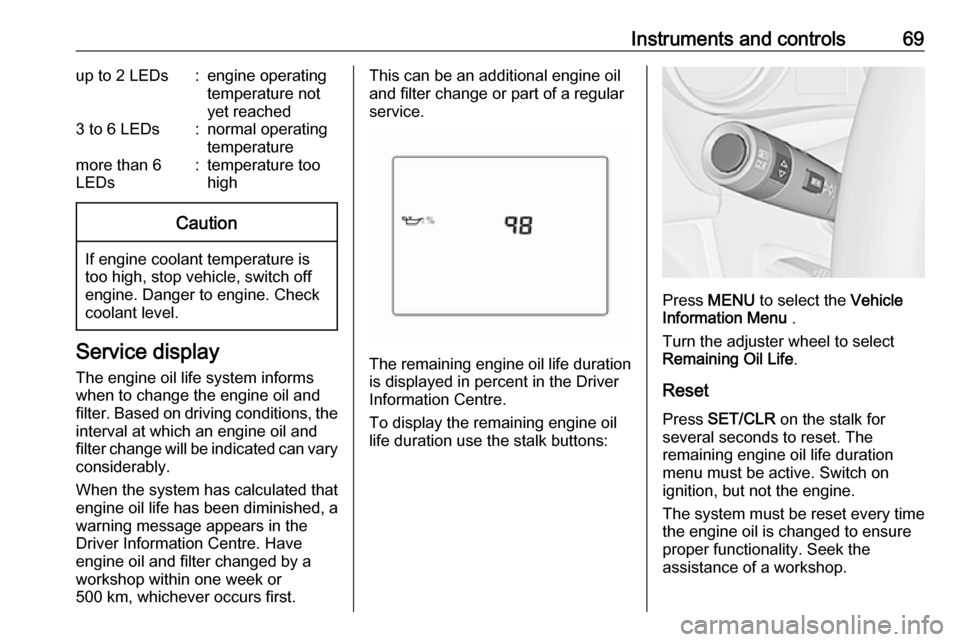
Instruments and controls69up to 2 LEDs:engine operating
temperature not
yet reached3 to 6 LEDs:normal operating
temperaturemore than 6
LEDs:temperature too
highCaution
If engine coolant temperature is
too high, stop vehicle, switch off
engine. Danger to engine. Check
coolant level.
Service display
The engine oil life system informs
when to change the engine oil and
filter. Based on driving conditions, the interval at which an engine oil and
filter change will be indicated can vary
considerably.
When the system has calculated that
engine oil life has been diminished, a warning message appears in theDriver Information Centre. Have
engine oil and filter changed by a
workshop within one week or
500 km, whichever occurs first.
This can be an additional engine oil
and filter change or part of a regular
service.
The remaining engine oil life duration
is displayed in percent in the Driver
Information Centre.
To display the remaining engine oil
life duration use the stalk buttons:
Press MENU to select the Vehicle
Information Menu .
Turn the adjuster wheel to select
Remaining Oil Life .
Reset Press SET/CLR on the stalk for
several seconds to reset. The
remaining engine oil life duration
menu must be active. Switch on
ignition, but not the engine.
The system must be reset every time
the engine oil is changed to ensure
proper functionality. Seek the
assistance of a workshop.
Page 74 of 203
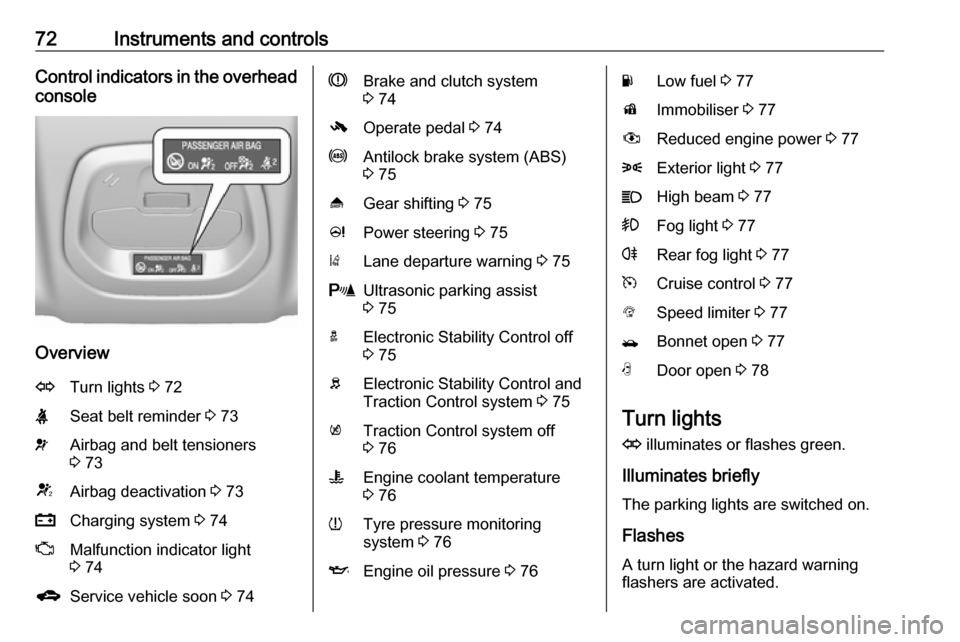
72Instruments and controlsControl indicators in the overhead
console
Overview
OTurn lights 3 72XSeat belt reminder 3 73vAirbag and belt tensioners
3 73VAirbag deactivation 3 73pCharging system 3 74ZMalfunction indicator light
3 74gService vehicle soon 3 74RBrake and clutch system
3 74-Operate pedal 3 74uAntilock brake system (ABS)
3 75[Gear shifting 3 75cPower steering 3 75)Lane departure warning 3 75rUltrasonic parking assist
3 75aElectronic Stability Control off
3 75bElectronic Stability Control and
Traction Control system 3 75kTraction Control system off
3 76WEngine coolant temperature
3 76wTyre pressure monitoring
system 3 76IEngine oil pressure 3 76YLow fuel 3 77dImmobiliser 3 77#Reduced engine power 3 778Exterior light 3 77CHigh beam 3 77>Fog light 3 77rRear fog light 3 77mCruise control 3 77LSpeed limiter 3 77/Bonnet open 3 77NDoor open 3 78
Turn lights
O illuminates or flashes green.
Illuminates briefly The parking lights are switched on.
Flashes
A turn light or the hazard warning flashers are activated.
Page 78 of 203
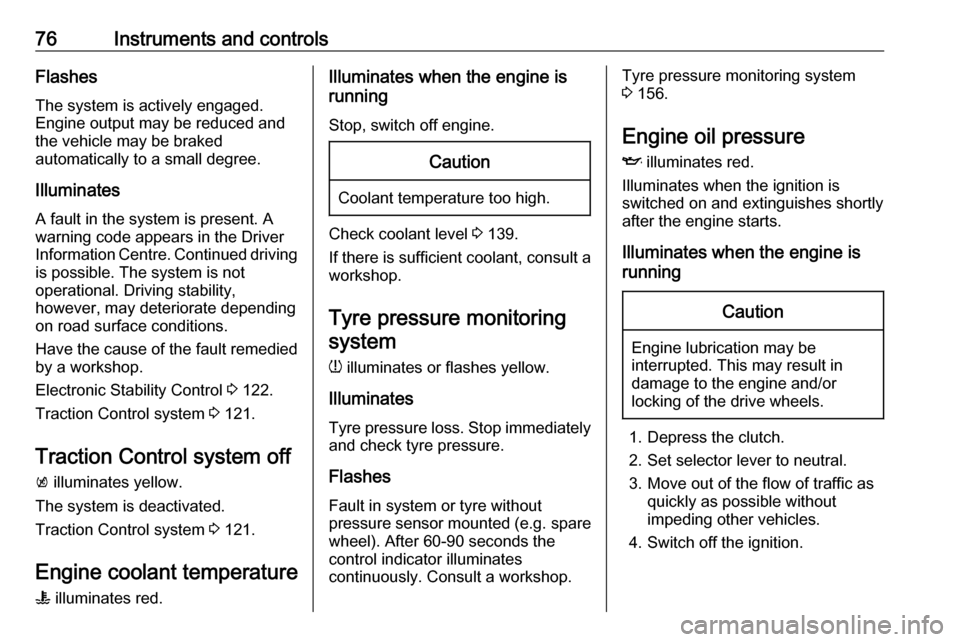
76Instruments and controlsFlashes
The system is actively engaged. Engine output may be reduced and
the vehicle may be braked
automatically to a small degree.
Illuminates
A fault in the system is present. A
warning code appears in the Driver
Information Centre. Continued driving
is possible. The system is not
operational. Driving stability,
however, may deteriorate depending on road surface conditions.
Have the cause of the fault remedied
by a workshop.
Electronic Stability Control 3 122.
Traction Control system 3 121.
Traction Control system off
k illuminates yellow.
The system is deactivated.
Traction Control system 3 121.
Engine coolant temperature
W illuminates red.Illuminates when the engine is
running
Stop, switch off engine.Caution
Coolant temperature too high.
Check coolant level 3 139.
If there is sufficient coolant, consult a workshop.
Tyre pressure monitoring system
w illuminates or flashes yellow.
Illuminates
Tyre pressure loss. Stop immediately
and check tyre pressure.
Flashes
Fault in system or tyre without
pressure sensor mounted ( e.g. spare
wheel). After 60-90 seconds the
control indicator illuminates
continuously. Consult a workshop.
Tyre pressure monitoring system
3 156.
Engine oil pressure
I illuminates red.
Illuminates when the ignition is
switched on and extinguishes shortly
after the engine starts.
Illuminates when the engine is
runningCaution
Engine lubrication may be
interrupted. This may result in
damage to the engine and/or
locking of the drive wheels.
1. Depress the clutch.
2. Set selector lever to neutral.
3. Move out of the flow of traffic as quickly as possible without
impeding other vehicles.
4. Switch off the ignition.
Page 87 of 203

Instruments and controls85Vehicle messages in Driver
Information Centre
The vehicle messages are displayed
as code numbers.
No.Vehicle message3Engine coolant level low4Air conditioning off11Brakes worn12Vehicle overloaded13Compressor overheatedNo.Vehicle message15Centre high-mounted brake
light failure16Brake light failure17Headlight levelling malfunction18Left low beam failure19Rear fog light failure20Right low beam failure21Left sidelight failure22Right sidelight failure23Reversing light failure24Number plate light failure25Left front turn light failure26Left rear turn light failure27Right front turn light failure28Right rear turn light failure35Replace battery in radio remote
control36ESC InitialisingNo.Vehicle message49Lane departure warning unavailable52Change timing belt56Tyre pressure imbalance on
front axle57Tyre pressure imbalance on
rear axle59Open, then close driver window60Open, then close front
passenger window61Open, then close left rear
window62Open, then close right rear
window65Theft attempted66Service anti-theft alarm system67Service steering wheel lock68Service power steering75Service air conditioning
Page 114 of 203
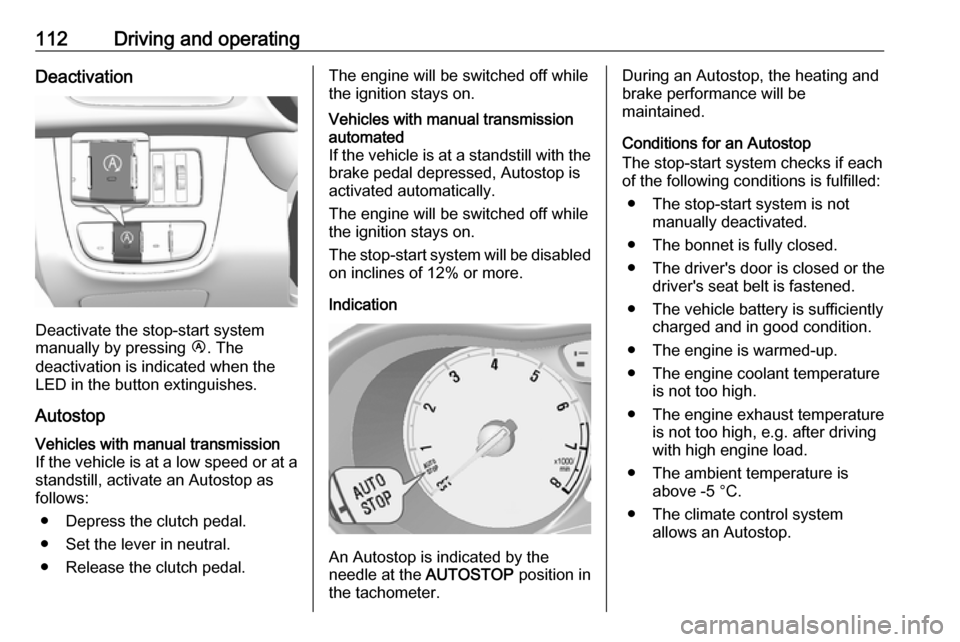
112Driving and operatingDeactivation
Deactivate the stop-start system
manually by pressing Ï. The
deactivation is indicated when the
LED in the button extinguishes.
Autostop
Vehicles with manual transmission
If the vehicle is at a low speed or at a
standstill, activate an Autostop as
follows:
● Depress the clutch pedal.
● Set the lever in neutral.
● Release the clutch pedal.The engine will be switched off while
the ignition stays on.Vehicles with manual transmission
automated
If the vehicle is at a standstill with the brake pedal depressed, Autostop is
activated automatically.
The engine will be switched off while
the ignition stays on.
The stop-start system will be disabled
on inclines of 12% or more.
Indication
An Autostop is indicated by the
needle at the AUTOSTOP position in
the tachometer.
During an Autostop, the heating and
brake performance will be
maintained.
Conditions for an Autostop
The stop-start system checks if each
of the following conditions is fulfilled:
● The stop-start system is not manually deactivated.
● The bonnet is fully closed.
● The driver's door is closed or the driver's seat belt is fastened.
● The vehicle battery is sufficiently charged and in good condition.
● The engine is warmed-up.
● The engine coolant temperature is not too high.
● The engine exhaust temperature is not too high, e.g. after driving
with high engine load.
● The ambient temperature is above -5 °C.
● The climate control system allows an Autostop.
Page 137 of 203

Vehicle care135Vehicle careGeneral Information...................135
Accessories and vehicle modifications .......................... 135
Vehicle storage ........................136
End-of-life vehicle recovery .....136
Vehicle checks ........................... 137
Performing work ......................137
Bonnet ..................................... 137
Engine oil ................................. 138
Engine coolant ......................... 139
Washer fluid ............................ 140
Brakes ..................................... 140
Brake fluid ............................... 140
Vehicle battery ......................... 140
Wiper blade replacement ........142
Bulb replacement .......................143
Halogen headlights ..................143
Fog lights ................................. 145
Front turn lights .......................145
Tail lights ................................. 146
Side turn lights ......................... 147
Centre high-mounted brake light ......................................... 147
Number plate light ...................148Interior lights ............................ 148
Instrument panel illumination ...148
Electrical system ........................149
Fuses ....................................... 149
Engine compartment fuse box . 150
Instrument panel fuse box .......152
Vehicle tools .............................. 153
Tools ........................................ 153
Wheels and tyres .......................154
Winter tyres ............................. 154
Tyre designations ....................154
Tyre pressure .......................... 155
Tyre pressure monitoring
system .................................... 156
Tread depth ............................. 159
Changing tyre and wheel size . 159 Wheel covers ........................... 160
Tyre chains .............................. 160
Tyre repair kit .......................... 160
Wheel changing .......................163
Spare wheel ............................ 166
Jump starting ............................. 168
Towing ....................................... 169
Towing the vehicle ...................169
Appearance care .......................170
Exterior care ............................ 170
Interior care ............................. 172General Information
Accessories and vehiclemodifications
We recommend the use of genuine
parts and accessories and factory approved parts specific for your
vehicle type. We cannot assess or
guarantee reliability of other products
- even if they have a regulatory or
otherwise granted approval.
Any modification, conversion or other changes made to standard vehicle
specifications (including, without
limitation, software modifications,
modifications of the electronic control
units) may invalidate the warranty
offered by Opel. Furthermore, such
changes may affect driver assistance
systems, fuel consumption, CO 2
emissions and other emissions of the
vehicle. They may also invalidate the
vehicle operating permit.
Page 138 of 203

136Vehicle careCaution
When transporting the vehicle on
a train or on a recovery vehicle, the
mud flaps might be damaged.
Vehicle storage
Storage for a long period of time
If the vehicle is to be stored for several months:
● Wash and wax the vehicle.
● Have the wax in the engine compartment and underbody
checked.
● Clean and preserve the rubber seals.
● Fill up fuel tank completely.
● Change the engine oil.
● Drain the washer fluid reservoir.
● Check the coolant antifreeze and
corrosion protection.
● Adjust tyre pressure to the value specified for full load.
● Park the vehicle in a dry, wellventilated place. Engage first or
reverse gear. Prevent the vehicle from rolling.
● Do not apply the parking brake.
● Open the bonnet, close all doors and lock the vehicle.
● Disconnect the clamp from the negative terminal of the vehicle
battery. Beware that all systems are not functional, e.g. anti-theft
alarm system.
Putting back into operation When the vehicle is to be put back into
operation:
● Connect the clamp to the negative terminal of the vehicle
battery. Activate the electronics
of the power windows.
● Check tyre pressure.
● Fill up the washer fluid reservoir.
● Check the engine oil level.
● Check the coolant level.
● Fit the number plate if necessary.End-of-life vehicle recovery
Information on end-of-life vehicle
recovery centres and the recycling of
end-of-life vehicles is available on our
website. Only entrust this work to an
authorised recycling centre.
Gas vehicles must be recycled by a
service centre authorised for gas
vehicles.